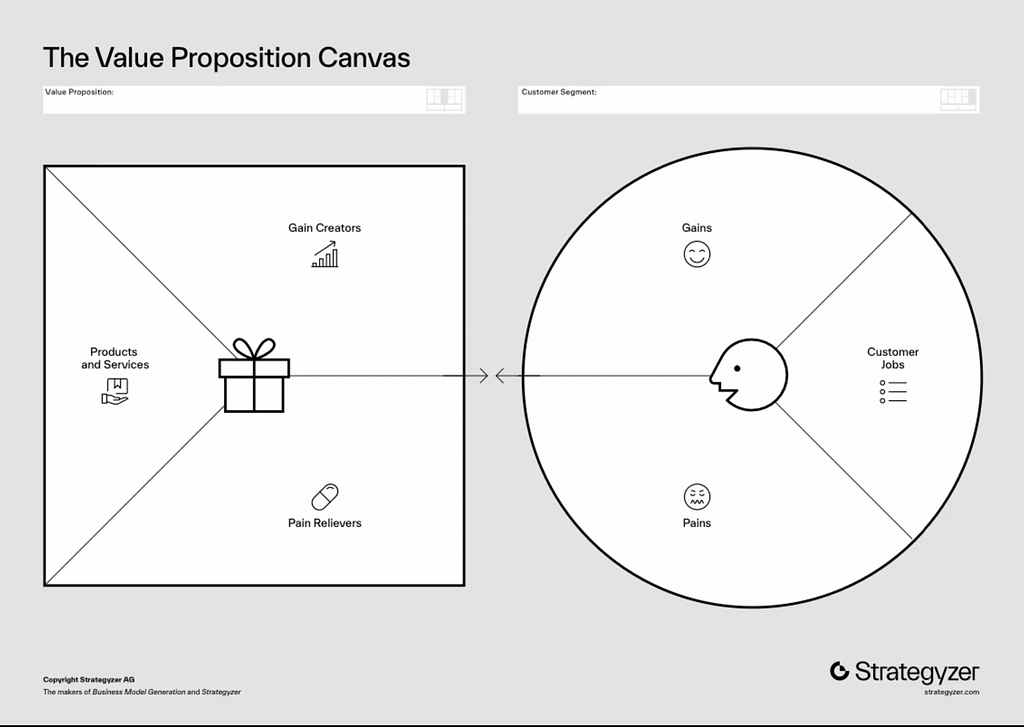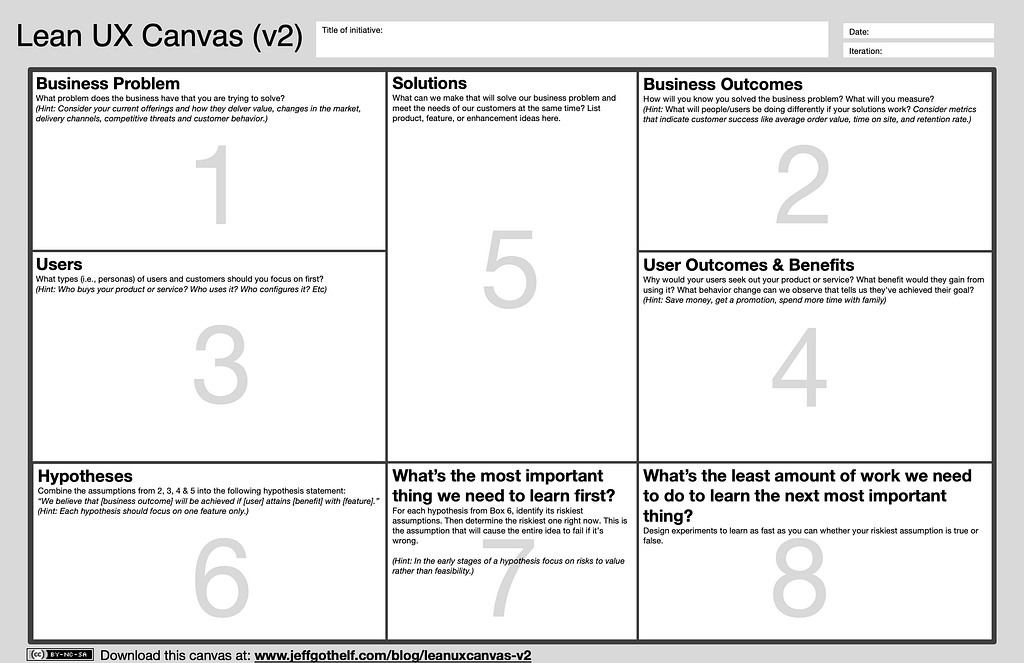
The canvases listed below can streamline the product design process and will help you consider the bigger picture when doing individual design activities.
1. Business Model Canvas (BMC)
BMC is a tool used to map out key elements of a business model in a single page. It visualizes how the business operates and creates value.

BMC components
- Customer segments: Different groups of people or organizations that your business aims to serve.
- Value propositions: The products or services that create value for each customer segment.
- Channels: How your company communicates with and reaches its customer segments to deliver the value proposition.
- Customer relationships: Types of relationships a company establishes with specific customer segments.
- Revenue streams: How your company makes money from each customer segment.
- Key resources: The most important assets required to make your business model work (e.g., physical, intellectual, human, financial resources).
- Key activities: The most important actions a company must take to operate successfully.
- Key partnerships: The network of suppliers and partners that help the business operate.
- Cost structure: All the costs involved in running the business model.
When to use BMC
When you want to have a snapshot of your current state of business. BMC offers a clear, visual snapshot of how all the components of a business fit together.
Tips for making the most of BMC
- Start with the Customer Segments and Value Propositions. These are the core of your business model. Everything else flows from understanding who your customers are and what value you’re delivering to them.
- Start with a broad view, then refine. The BMC works best when you initially brainstorm all possibilities without being overly specific.
- Validate your assumptions. Some of the items you place on the BMC are based on assumptions, and these need to be validated with real-world feedback.
2. Value Proposition Canvas
Value Proposition Canvas focuses specifically on the customer segments and value propositions to ensure product-market fit. It complements the BMC by providing a deeper dive into customer needs and how a company’s products address those needs.

Value Proposition Canvas components
- Customer Profile (right side). This section helps you get a deeper understanding of your target customers. It includes three key components: customer jobs (the tasks, problems, or needs that the customer wants to address), customer pains (the negative experiences, risks, or obstacles that prevent customers from completing their jobs or that cause them frustration), and customer gains (the desired outcomes or benefits customers seek, including positive experiences, improvements, or satisfactions)
- Value Map (left side). This section helps you clarify how your product or service creates value for your customer segments. It includes three key components: Products & Services (A list of what your business offers that helps customers complete their jobs), Pain Relievers (How your products or services reduce or eliminate customer pains) and Gain Creators (How your products or services create benefits and enhance customer satisfaction).
When to use Value Proposition Canvas
When you want to establish strong value proposition. The goal is to match the Customer Profile with the Value Map. By ensuring a good “fit” between these two sides, you create a strong value proposition that resonates with customers.
Tips for making the most of Value Proposition Canvas
- Invest in user/customer research. The canvas is only as strong as your understanding of the customer. Assumptions about customer needs can lead to mismatches between what you offer and what they want.
- Prioritize customer jobs, pains, and gains. Not all jobs, pains, and gains are equally important. Prioritizing helps focus on the most critical areas where you can deliver value.
- Focus on emotional and social jobs, not just functional ones. Customers often choose products for emotional or social reasons, not just functional benefits.
3. Lean UX Canvas
Lean UX Canvas is a tool designed to help teams quickly capture and validate their ideas, with focus on user experience and iterative development.

Lean UX Canvas components
- Business problem: This is where you define the main business challenge you’re trying to solve.
- Business outcomes: In this section, you specify how success will be measured. These are typically metrics that align with business goals, such as revenue growth, user engagement, or retention rates.
- Users: Here, you identify the types of users or personas who are most relevant to solving the problem.
- User outcomes & benefits: This box focuses on why the identified users will want to engage with the solution. It outlines the value the users will derive and the positive behavioral change they may experience.
- Solutions: In this section, brainstorm possible solutions that could address the business problem and meet the users’ needs.
- Hypotheses: Here, you formulate hypotheses that combine the business problem, user needs, and potential solutions.
- What’s the most important thing we need to learn first? This section focuses on prioritizing what needs to be validated first.
- What’s the least amount of work we need to do to learn the next most important thing? This is about designing minimal experiments to validate the hypotheses or assumptions in the previous box.
When to use Lean UX Canvas
When you need to quickly align on the problem you are solving, validate ideas, and prioritize learning. Lean UX canvas is particularly effective in startup environments where speed, collaboration, and learning are paramount.
Tips for making the most of Lean UX Canvas
- Start with problem statements, not solutions. Lean UX emphasizes solving the right problem rather than jumping to a solution too early.
- Identify and prioritize assumptions. Lean UX is built around validating or disproving assumptions quickly to reduce risk.
- Think in terms of hypotheses, not features. Instead of listing potential product features, phrase your ideas as hypotheses. For example, “We believe that users need a faster checkout process because they abandon carts at high rates” or “We believe adding a visual progress tracker will reduce task abandonment.” This keeps your focus on learning, not building.
4. UX Research Canvas
UX Research Canvas is a tool designed to help teams plan, organize, and conduct user research in a structured way.

UX Research Canvas components
- Why (Research Objectives): The high-level goals or outcomes you aim to achieve through the research.
- Key Research Questions: The specific questions you want your research to answer. These questions will help you stay aligned with your research goals and prevent scope creep.
- Assumptions: Your assumptions about users or behaviors that you want to test and validate through the research. These will guide your research questions and methods.
- Type of research: The nature of your research — Foundation, Exploratory, Generative or Evaluative research.
- Recruitment criteria (research participants): The types of participants who will participate in the research. Identify the user segments or personas you need to include in the research to ensure you’re collecting relevant insights.
- UX Research Methods: The techniques or approaches you’ll use to gather insights. Methods could include user interviews, surveys, usability testing, field studies, or A/B testing.
- Success Metrics: How you’ll measure success. Define the qualitative and quantitative data you aim to collect and the key metrics or indicators you’ll use to evaluate your findings.
Tips for making the most of UX research Canvas
- Clarify research objectives: A clear objective focuses your research and helps avoid distractions.
- Involve stakeholders early: Collaboration ensures alignment and buy-in from the beginning, preventing misunderstandings about research priorities.
- Set clear success metrics up front: Defining success ensures you can measure the impact of your research and know when you’ve answered your research questions.
Want To Master Product Design?
Try Interaction Design Foundation. It offers online design courses that cover the entire spectrum of product design, from foundational to advanced level.
This post contains affiliate link(s)
4 Popular Canvases for Product Design was originally published in UX Planet on Medium, where people are continuing the conversation by highlighting and responding to this story.